How to design a kid-friendly dining space for family mealtimes
We reveal the key things to think about before designing your family's dining area
Aside from the kitchen, dining spaces are often one of the hardest working spots of the household where multiple family members congregate, whether that’s to catch up on the day, for mealtimes, homework, crafting or more often than not, ‘debating’… So it’s an area of the home that has to work hard and be multifunctional as well as stylish. We delve into the details that can help make this space work harder for your family.
Choose the right dining table
The dining table is the hub of the home – the meeting point for family mealtimes, get-togethers and entertaining (when we have the time, energy and inclination). It also serves as a space to work, craft, do homework etc, so it needs to withstand a lot of daily activities, as well as be practical and stylish. A reclaimed wood-topped dining table or an already-battered farmhouse table that has its charming ‘patina’ are both sustainable options that mean you’ll be less precious about dents and scrapes, which can also be sanded back when needed. Another alternative is hardwood veneer, which has the look and feel of natural wood, combined with an easy-care, durable surface that will hold up to bangs and bumps from chairs, children and toys. Melamine surfaces are also an affordable option that will withstand pretty much anything your kids will throw at them, as well as being moisture and scratch resistant.
The size of your dining table also matters – you don’t want it to be like an island between you and your children, constantly having to reach over to cut their food, so consider a smaller table that has the ability to be extended for larger gatherings. Round or oval tables are better in compact spaces as they take up a smaller footprint, plus they’re great for facilitating conversation (ideal for encouraging small talk between any non-communicative tweens and teens). Rounded edges in general are also better to avoid bumps and cuts – dining tables are often inconveniently at child head-height…
Another thing that often gets bypassed is the dining table legs – consider an option that has a central pedestal over legs, as not only does it make getting in and out easier from around the table, but if you’ve got a highchair or two, they can often become quite prohibitive.
Nail the seating
How many times have you been out for dinner or visited a friend’s houses and your children are comically peering over the dining table edge because the seat is too low? A transitional high chair that will serve your child from the early years through to tweens is worth the investment – consider the legs on this too, as sometimes they can have quite a wide ‘stance’ and the legs can pose as a bit of a trip hazard when sat around a dining table. Moji, Kaos and Stokke all sell stylish chairs that can be used from birth to adulthood. Another option is going old school – we’ve got a vintage spindle-back high chair at home that I found off of Facebook Marketplace for a fiver. I like it as it’s more compact footprint wise, plus it doesn’t look out of place with the rest of our Ercol dining chairs. Booster seats are also worth considering if you’d prefer to avoid bulky high chairs, but you’ll need to factor in the seat size of your dining chair – we discovered that our slender chairs at home weren’t wide enough to accommodate a booster seat safely, so you’d need a pretty generous seat for it to work.
The other failsafe seating option is a bench seat – you may have seen us banging on about them before, but who doesn’t love a bench seat? You go to a restaurant with kids and they’ll always gravitate towards a booth and somehow it seems more ‘fun’ to sit on one, so they’re always a winner in my book. Plus you can fit more bums on seats when you have playdates and parties. You can boost them up with some generous bench pads and extra cushions (go for indoor/outdoor fabric for wipeability), and bench seats are always great for providing extra storage.
Don’t underestimate the details
My mum always had a wipeable oilcloth table cover when we were kids (in William Morris print obviously – she was ahead of her time), and I always thought it was a bit OTT. But now I get it. I even nicked it off her when she was going to chuck it away after all these years (I have it on the table right now in fact). The amount of drink spillages/ Play-Doh/ spag-bol stains/ glue/ pen scribbles/ etc. it’s seen is unreal. I started with a pretty fabric tablecloth and obviously it just got trashed. Save them for best, honestly. Or, if you’re brave, leave your wooden table uncovered, especially if it’s got that ‘patina’ we spoke about. It depends how Monica you are about these things – either it’ll make you a bit anal or you won’t care a flying fig. I’m always a bit suspicious of wipeable placemats (whatever you do, don’t get rattan ones like us unless you like picking food out of the tightly woven strands), but there are a few stylish options out there on the market now – I wouldn’t mind these on my table for example (but they are £120).
Rugs are always a contentious issue – obviously they aren’t the most practical when you know for a fact they’ll be covered in food, but they DO help zone an open-plan space / add another decorative element / soften the space, etc, so there are plenty of benefits of having one. The trick is to make sure the rug is large enough so that the chairs don’t ‘fall’ off the edge of the rug and also to choose something that is washable or indoor-outdoor so that you can scrub it/chuck it in the washing machine without needing to feel too precious about it. Again, as much as natural grass rugs look nice here and might feel aesthetically the right choice, they’re sadly just not a practical solution.
Lighting is also important to get right – the dining table needs to feel atmospheric for evening suppers and entertaining but often you’ll also need ample task lighting for darker evenings when the kids are doing homework or crafting activities, for example. Wall lights and pendant lighting on dimmer switches are ideal, but there’s also now a whole host of clever wireless and battery-operated lighting solutions that mean you can easily retrofit additional lighting if you need it.
What other rooms in your family home do you need design help with? Let us know in the comments below.









